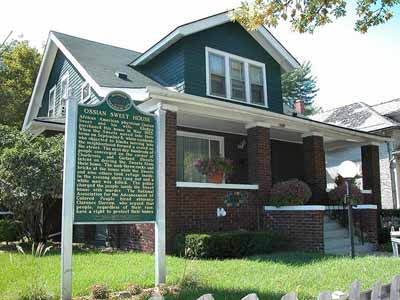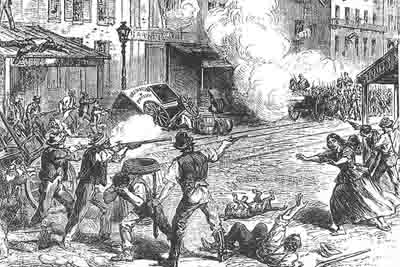Race

(Dr. Ossian Sweet’s house at 2905 Garland Street in East Detroit.)
“There is a saying among Southern blacks that goes like this: White folks up North don’t care how high you get as long as you don’t get too close; white folks down South don’t care how close you get as long as you don’t get too high.”
– MARYANNE VOLLERS in her review of Edward Ball’s best selling examination of his plantation family’s history “Slaves in the Family.”
Well, I guess I can’t avoid it any longer, but I need to mention the central issue in why a great but flawed city died. It is about race, racism, and the spin downward from some really bad shit. You could start it with the insurrection of Pontiac, the last of the great chiefs who confronted white expansion in the Northwest Territories, but that is a rabbit hole of wonders we will have to put aside for now.
My discomfort this morning is amplified by an early meeting in the place I like second-least to drive to: traffic-clogged Fairfax, Virginia.
See, I was going to tell you about the Detroit I moved back to in the summer of 1973.
It was a markedly different city from what it had been, transformed by the riots of a half-decade before. The last ditch of the old order was the 1973 Mayoral campaign of the last Great White Hope, Police Commissioner John Nichols versus a social activist and former Tuskegee Airman named Coleman Young.
Man, there was a lot going on that year. The US was pulling out of Vietnam; the OPEC thugs were about to pull the plug on the American economy. I was graduating from college and leaving the good auspices of The International Bank of Dad.
I need to do a brief tribute to Coleman Young, the African-American who beat Commissioner Nichols, but that takes a morning all to itself. I heard an interesting dual dialogue on the radio in DC late yesterday between ex-Mayor for life Marion Barry and Young successor Dennis Archer that gave me some context.
The two men presided on some amazing demonstrations of democracy in action, though as far as I know, only former Mayor Barry actually did any jail time for them. They both have some interesting ideas about what is going on today, but that is not the point of this outing, and it is important to know that Mayor Barry is still a serving Council member for Ward 8 of the District.
It was sort of weird, like listening to an inverted version of the news on All-India Radio, but that is the nature of what of what passes for talk on the subject of race in these Untied States.
The rhetoric was largely invective, which is to say that the two men I heard on the radio were campaigning against the very power structure they both have been members of all their lives. I do not have the voice to figure it out properly, but I know someone who does.
Big John Minter could explain it, if he is still alive.
Big John was the African American who taught me the parking lot game when I was a kid, a man of vast proportions and intellect. He taught me how to slim-jim a car door, scope the lot for opportunities, scan the NY Times list of current literature and detect management bullshit.
He was an artist, able to shake down the The Man with his righteous rage at Demery’s Department Store in downtown Grabbingham, too.
He persuaded- intimidated- the store into providing him a ticket to represent the store at Dr. King’s memorial in Washington the year after the ’67 riots.
At the height of the riots that summer, John told me about sitting sat on his porch downtown with a shotgun on his knee, watching the insurrection unfold. He still made it to work out in the suburbs during the day where the National Guard had established check-points.
Imagine that- Armored personnel carriers and nervous reservists in Grabbingham! “They” were coming!
It was not that things hadn’t been going south for the Motor City for years. The zenith of the population inside the city limits, which effectively meant east of 8 Mile to the Detroit river, rose to a rainbow of nearly two million citizens in the war years.
The pressure on available housing was intense, and the Great Migration of African Americans north strained racial relations. There were antecedents to all that. Canada, and liberty, were right across the river from Detroit, so the Underground Railway had a terminus in the pre-motor City. While the volunteer Wolverines of the Iron Brigade served with distinction in the Union Army, there were also riots in the city about race resentment.

(The first and not the last riot about race in Detroit. March 6, 1863.)
At the time, the great riot of March 6, 1863, was reported as “the bloodiest day that ever dawned upon Detroit.”
While not as famous or destructive as the later riots, the one in the middle of the Civil War was certainly something that registered in Mr. Lincoln’s White House. The casualties of the day included at least two innocent people killed, a multitude of others, mostly African-American, mercilessly beaten. In an eerie tribute to the future, over thirty buildings were burned to the ground, and a number of other buildings were damaged by arson.
It does not sound like much in the context of what would come, but it was something else.
The riot was so alarming that it resulted in the creation of a full-time police force- the one headed up by John Nichols the year I moved back to the city.
The lingering tensions were evident in the 1920s trial of Dr. Ossian Sweet, a physician who happened to be black. He was acquitted of murder after a white man died when the Doctor fired into a threatening mob who gathered to try to force him out of a predominantly white neighborhood.
It got worse than that, and then the whites just gave up and left. But not all of them did. I will have to talk to you about that, and Coleman Young, and why some of my southern friends think everyone up north is crazy tomorrow.
I have to be in Fairfax. Crap.
Copyright 2011 Vic Socotra
www.vicsocotra.com
